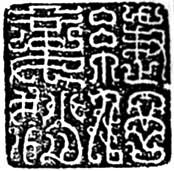1) concubined mother


妾妇型
2) Concubine
[英]['kɔŋkjubaɪn] [美]['kɑŋkju'baɪn]


妾
1.
Concubines Recorded in the Dunhuang and Turfan Documents;


敦煌吐鲁番出土社会文书中所见之妾
2.
The research object of this paper is the concubine s civil legal status in the family of Qing Dynasty.
本文以清代妾在家族中的民事法律地位为研究对象,首先阐明了论题的来由——清代语境中妾的地位是普遍性与特殊性的统一体以及学界对此相关研究的薄弱性,并对家族、家长、民法法律地位三个概念进行界说。
3.
Song Dynasty was an important transition period in history, likewise, the great change took place in the concubines’status and life state of the women of lower floor.
宋代是历史上一个重要的转变时期,同样,宋代下层妇女中妾的地位以及生活状态也发生了重大变化。
3) Concubines


妾
1.
An Analysis on the Social and Family Status of Concubines in Early Qing Dynasty from The Scholars;
从《儒林外史》看清初妾的社会与家庭地位
2.
The Status of "Concubines" in Late Qing Dynasty and Their Marital Condition——With the typical cases of "concubines" from 1899 to 1909 from Shenbao as centre of attention;
晚清“妾”之地位及婚姻状况——以《申报》1899-1909年“妾”之典型案例为中心
3.
Concubines resulted from the marriage system of monogamy with several concubines,and the system of concubines developed to the top in the Qing Dynasty.
妾是古代一夫一妻多妾婚姻制度的产物,妾制到清代发展到顶峰。
5) concubinage
[英][kɔn'kju:binidʒ] [美][kɑn'kjubənɪdʒ]


纳妾
1.
The article confutes the misreading of "melancholy" in Li Qingzhao s Ci - poetry, whose connotations were considered as her repugnance for supposed her husband Zhao Mingcheng s concubinage in the studies on Li Qingzhao in the recent years.
本文指出:陈祖美、朱清华等先生“破译”李清照词中大量“欲说还休”的愁情是抱怨赵明诚纳妾。
2.
This paper aims to find out the social roots of concubinage, a long-standing custom in ancient China, and analyzes the laws and features of the phenomenon.
本文旨在通过对清代纳妾现像的研究,了解纳妾习俗经久不衰的社会根源,并对这种现象的发展规律和特点进行深入分析。
补充资料:妾印

 妾
妾 印
印Seal of Imperial Concubine Zhao
中国西汉殉葬印。玉质,正方形,边长2.3厘米,雁纽,阴刻缪篆“

 妾
妾 ” 4 字。此印玉质洁白纯净,纽式精巧异常,笔画盘曲秀美,富于韵味,为罕见珍品。
” 4 字。此印玉质洁白纯净,纽式精巧异常,笔画盘曲秀美,富于韵味,为罕见珍品。
 文献作
文献作
 ,为汉代宫中女官。 汉武帝时置,同置的女官还有
,为汉代宫中女官。 汉武帝时置,同置的女官还有 娥、
娥、 华、 充依。 西汉前后所置凡14 种,最高的称昭仪,位比丞相,爵比诸侯王。
华、 充依。 西汉前后所置凡14 种,最高的称昭仪,位比丞相,爵比诸侯王。
 为第二等,“视上卿,比列侯”,地位亦很高。[]
为第二等,“视上卿,比列侯”,地位亦很高。[]
汉代官印除皇帝特许者外,死后都要上缴。当时人们很迷信,认为死者生前使用之物,死后也要使用,而所用的官印又不可殉葬,于是就多仿刻死者生前官印殉入墓中,这就是殉葬印。汉镌有官名的殉葬印质地与实用官印质地并不完全相同,今除见有铜印外,还有石、玉、木等。印文有的与原印一致,更多的是官名后加死者名字。此印第四字“
 ”就是死者的名,第 3字“妾”是死者的谦称。
”就是死者的名,第 3字“妾”是死者的谦称。此印传为北宋时出土,明时转归李氏六砚斋收藏,入清后,又相继归龚自珍、潘仕成等著名金石家,后入陈介祺万印楼。1957年入藏于故宫博物院。前人有谓此印为西汉成帝时

 赵飞燕印则无据。
赵飞燕印则无据。叶其峰
说明:补充资料仅用于学习参考,请勿用于其它任何用途。
参考词条